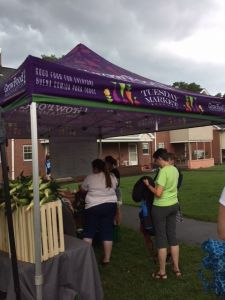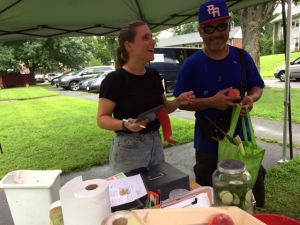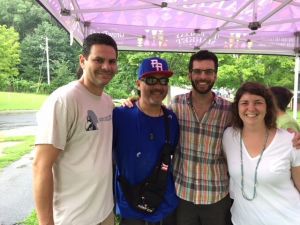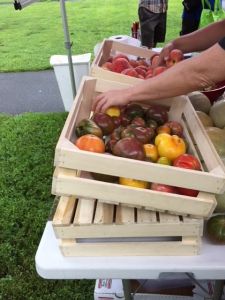August 23, 2018
August 23, 2018
Mobile Market Pilot Brings Healthy Food Home
It’s a steamy late afternoon in August. Storm clouds churn overhead while thunder rumbles nearby. Staff from Grow Food Northampton are putting the finishing touches on their mobile market, a pilot program underwritten in part by Cooley Dickinson, that brings fresh, local fruits and vegetables to several Northampton housing communities.
Crates of corn, peppers, potatoes, cucumbers, tomatoes, and peaches line tables that are positioned strategically beneath a tent. Bunches of kale and fennel are stacked on their sides. Slices of cucumber float among ice cubes in a container of water that awaits the next thirsty passerby.
“For the past three weeks we have been here setting up, there has been a threat of rain,” says Michael Skillicorn, director of programs for Grow Food Northampton. “And here it is.”
Almost on cue, steady rain begins to fall. Shopping bags in hand, the few people who have gathered outside the tent now seek shelter under the tent.
Making Food Affordable
“This is the first time at a housing community,” Skillicorn says of the pilot program. We have done programs like this at senior centers and at elementary schools, which Cooley has also supported.”
Skillicorn explains that the funds from Cooley Dickinson provide an essential component to the mobile market: to make the food sold in two Northampton housing communities – Hampshire Heights and Meadowbrook – affordable for the people who are buying it.
In essence, Grow Food purchases food from farms at wholesale rates. “We want to make the farmers whole and pay them what they need to be paid. The funds from Cooley help bridge the gap between what farmers need and what people can afford. The food is sold at wholesale rates for people who may buy several ear of corn or a melon and about 75% off wholesale rates for people who sign up for a share. It’s that subsidy that comes from Cooley Dickinson.”
It’s All About Access

Edgardo Cancel, a Hampshire Heights resident and one of the people who helped bring the mobile market to his community, says it’ s all about access.
“There are a lot of folks here who are limited as far as transportation. We see these awesome farmers’ markets downtown. This program brings the farmers’ market here; it helps people get a taste of what’s possible in terms of eating fresh and organic. It provides healthier options for everyone.”
While Grow Food Northampton operates the mobile market, Healthy Hampshire, a public health initiative funded through the Mass Department of Public Health, has worked behind the scenes along with Cooley Dickinson’s Healthy Communities Committee to identify the need, determine actionable strategies, and collect data.
“We focus on healthy eating and active living, and supporting access to healthy food is a big part of what we do,” says Healthy Hampshire Coordinator Caitlin Marquis.

Behind-the-Scenes Efforts
Marquis notes planning for the mobile market, which is just one of several strategies to provide fresh food to low-income residents, began in early 2017. It was a food access assessment, part of an overall community needs assessment featuring surveys of residents, countywide mapping, and audits of the food retail environment, that identified the need.
Next steps brought together an ad-hoc Food Access Advisory Committee, which included representation from Cooley Dickinson and Grow Food Northampton. Cancel co-facilitated the group along with Healthy Hampshire and the Pioneer Valley Planning Commission.
Marquis adds that in addition, several residents from Meadowbrook, the other mobile market pilot site, were supported by stipends from Cooley Dickinson to participate in the committee. “Extensive participation of the residents in the formulation – and now the execution [of the mobile market] – is what makes the initiative particularly rewarding to see it come to fruition.”
Barriers to Food: Transportation and Distribution
“For people who live in community housing, especially those with mobility issues, the two biggest barriers to food are transportation and distribution. People who live here liked the idea of the food coming to them,” she says.
 Just five weeks into the mobile market pilot, Skillicorn, Marquis, and Cancel are excited to see the fruits of their collective labor. So far the mobile market has shown it is successful enough to continue, but long term it will be funding-dependent. Measurement, Skillicorn notes, will be at a “mix of concrete data about the number of vegetables going out to the community, for example, coupled with qualitative self-reported data from people themselves.”
Just five weeks into the mobile market pilot, Skillicorn, Marquis, and Cancel are excited to see the fruits of their collective labor. So far the mobile market has shown it is successful enough to continue, but long term it will be funding-dependent. Measurement, Skillicorn notes, will be at a “mix of concrete data about the number of vegetables going out to the community, for example, coupled with qualitative self-reported data from people themselves.”
“The point I really want to hit home is that this [effort] has come from a long process and a lot of engagement from participants from across the community,” Marquis says. “A lot of people have worked really hard to get to this point and to figure out there is a strategy that works. It’s incredibly exciting to see it come to fruition after all this time.”
Local residents working on the food systems assessment identified the mobile market as their top priority. “I’m so glad we are able to help the project get started. The mobile market will give people in Hampshire Heights and Meadowbrook another option for buying healthy food,” said Jeff Harness, Director, Community Health at Cooley Dickinson.
How Cooley Dickinson’s Funding Benefits the Community
Through its healthy communities initiatives, Cooley Dickinson funds community projects that address unmet needs discovered through its triannual community health needs assessment.
Cooley Dickinson Health Care has funded a variety of local programs, among them the mobile market initiative. According to Harness, it is estimated that unhealthy diets and inadequate physical activity contribute to nearly 500,000 deaths each year. “Helping to develop local food systems is essential to creating conditions where people can lead healthier lives.”
-30-

